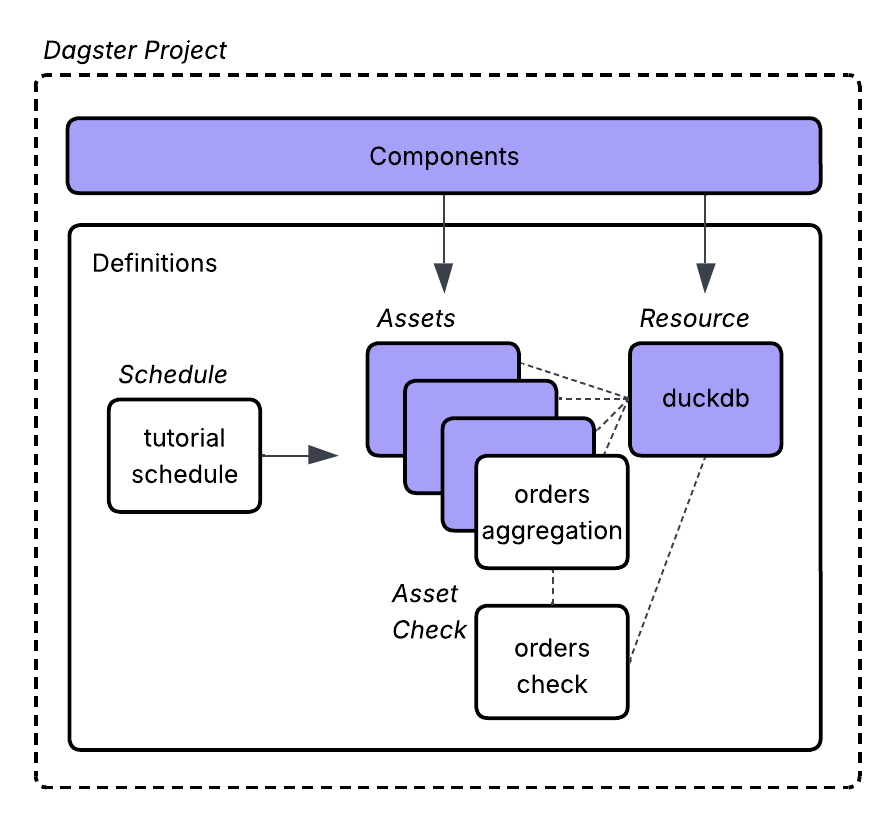Components
So far, we have built our pipeline out of existing Definitions, but this is not the only way to include Definitions in a Dagster project.
If we think about the code for our three assets (customers, orders, and payments), it is all very similar. Each asset performs the same action, turning an S3 file into a DuckDB table, while differing only in the URL path and table name.
These assets are a great candidate for a custom component. Components generate Definitions through a configuration layer. There are built-in components that let you integrate with common workflows (such as turning Python scripts into assets), or dynamically generate Definitions for tools like dbt or Fivetran. With custom components, you can define your own specific use cases.
In this step, you will use a custom component to streamline the development of similar assets and replace their Definitions in your project with a Component that can generate them from a a YAML configuration file instead.

1. Scaffold a custom component
First, scaffold a custom component using dg:
dg scaffold component Tutorial
Creating module at: <YOUR PATH>/dagster-tutorial/src/dagster_tutorial/components
Scaffolded Dagster component at <YOUR PATH>/dagster-tutorial/src/dagster_tutorial/components/tutorial.py.
This adds a new directory, components, within src/dagster_tutorial:
src
└── dagster_tutorial
├── __init__.py
├── components # NEW
│ ├── __init__.py
│ └── tutorial.py
├── definitions.py
└── defs
├── __init__.py
├── assets.py
├── resources.py
└── schedules.py
This directory contains the files needed to define the custom component.
2. Define the custom component
When designing a component, keep its interface in mind. In this case, the assets that the component will create share the following attributes:
- A DuckDB database shared across all assets.
- A list of ETL assets, each with a URL path and a table name.
The first step is to create a dg.Model for the ETL assets. dg.Model turns any class that inherits from it into a Pydantic model. This model is then used to implement the YAML interface from the component.
This model will contain the two attributes that define an asset:
import dagster as dg
class ETL(dg.Model):
url_path: str
table: str
Next, add the interface to the dg.Component class. In this case, there will be a single attribute for the DuckDB database and a list of the ETL models you just defined:
duckdb_database: str
etl_steps: list[ETL]
The rest of the code will look very similar to the asset definitions you wrote earlier. The build_defs method constructs a Definitions object containing all the Dagster objects created by the component. Based on the interface defined at the class level, you will generate multiple ETL assets. The final Dagster object to include is the resource that the assets rely on, which can also be set with an attribute.
from dagster_duckdb import DuckDBResource
class Tutorial(dg.Component, dg.Model, dg.Resolvable):
# The interface for the component
duckdb_database: str
etl_steps: list[ETL]
def build_defs(self, context: dg.ComponentLoadContext) -> dg.Definitions:
_etl_assets = []
for etl in self.etl_steps:
@dg.asset(
name=etl.table,
)
def _table(duckdb: DuckDBResource):
with duckdb.get_connection() as conn:
conn.execute(
f"""
create or replace table {etl.table} as (
select * from read_csv_auto('{etl.url_path}')
)
"""
)
_etl_assets.append(_table)
return dg.Definitions(
assets=_etl_assets,
resources={"duckdb": DuckDBResource(database=self.duckdb_database)},
)
Run the check again to ensure that the component code is correct:
dg check defs
All component YAML validated successfully.
All definitions loaded successfully.
3. Scaffold the component definition
If you list your components again, you should see that the custom component is now registered:
dg list components
┏━━━━━━━━━━━━━━━━━━━━━━━━━━━━━━━━━━━━━━━━━━━━━━━┳━━━━━━━━━━━━━━━━━━━━━━━━━━━━━━━━━━━━━━━━━━━━━━━━━━━━━━━━━━━━━━━━━━━━━━━━━━━━━┓
┃ Key ┃ Summary ┃
┡━━━━━━━━━━━━━━━━━━━━━━━━━━━━━━━━━━━━━━━━━━━━━━━╇━━━━━━━━━━━━━━━━━━━━━━━━━━━━━━━━━━━━━━━━━━━━━━━━━━━━━━━━━━━━━━━━━━━━━━━━━━━━━┩
│ dagster.DefinitionsComponent │ An arbitrary set of Dagster definitions. │
├───────────────────────────────────────────────┼─────────────────────────────────────────��────────────────────────────────────┤
│ dagster.DefsFolderComponent │ A component that represents a directory containing multiple Dagster │
│ │ definition modules. │
├───────────────────────────────────────────────┼─────────────────────────────────────────────────────────────────────────────┤
│ dagster.FunctionComponent │ Represents a Python function, alongside the set of assets or asset checks │
│ │ that it is responsible for executing. │
├───────────────────────────────────────────────┼─────────────────────────────────────────────────────────────────────────────┤
│ dagster.PythonScriptComponent │ Represents a Python script, alongside the set of assets and asset checks │
│ │ that it is responsible for executing. │
├───────────────────────────────────────────────┼─────────────────────────────────────────────────────────────────────────────┤
│ dagster.TemplatedSqlComponent │ A component which executes templated SQL from a string or file. │
├───────────────────────────────────────────────┼─────────────────────────────────────────────────────────────────────────────┤
│ dagster.UvRunComponent │ Represents a Python script, alongside the set of assets or asset checks │
│ │ that it is responsible for executing. │
├───────────────────────────────────────────────┼─────────────────────────────────────────────────────────────────────────────┤
│ dagster_tutorial.components.tutorial.Tutorial │ │
└───────────────────────────────────────────────┴─────────────────────────────────────────────────────────────────────────────┘
You can now scaffold definitions from it just like any other component:
dg scaffold defs dagster_tutorial.components.tutorial.Tutorial tutorial
Creating defs at <YOUR PATH>/dagster-tutorial/src/dagster_tutorial/defs/tutorial.
This adds a new directory, tutorials, within defs:
src
└── dagster_tutorial
├── __init__.py
├── components
│ ├── __init__.py
│ └── tutorial.py
├── definitions.py
└── defs
├── __init__.py
├── assets.py
├── resources.py
├── schedules.py
└── tutorial # NEW
└── defs.yaml
4. Configure the component
To configure the component, update the YAML file created when you scaffolded a definition from the component:
type: dagster_tutorial.components.tutorial.Tutorial
attributes:
duckdb_database: /tmp/jaffle_platform.duckdb
etl_steps:
- url_path: https://raw.githubusercontent.com/dbt-labs/jaffle-shop-classic/refs/heads/main/seeds/raw_customers.csv
table: customers
- url_path: https://raw.githubusercontent.com/dbt-labs/jaffle-shop-classic/refs/heads/main/seeds/raw_orders.csv
table: orders
- url_path: https://raw.githubusercontent.com/dbt-labs/jaffle-shop-classic/refs/heads/main/seeds/raw_payments.csv
table: payments
5. Remove the old definitions
Before running dg check again, remove the customers, orders, and payments assets from assets.py and the resource.py file. The component is now responsible for generating these objects (otherwise there will be duplicate keys in the asset lineage).
src
└── dagster_tutorial
├── __init__.py
├── components
│ ├── __init__.py
│ └── tutorial.py
├── definitions.py
└── defs
├── __init__.py
├── assets.py # UPDATED
├── schedules.py
└── tutorial
└── defs.yaml
6. Materialize the assets
When you materialize your assets in the Dagster UI at http://127.0.0.1:3000/assets, you should see that the asset graph looks the same as before.
Summary
Congratulations! You've just built a fully functional, end-to-end data pipeline. This is no small feat! You've laid the foundation for a scalable, maintainable, and observable data platform.
Recommended next steps
- Join our Slack community.
- Continue learning with Dagster University courses.
- Start a free trial of Dagster+ for your own project.